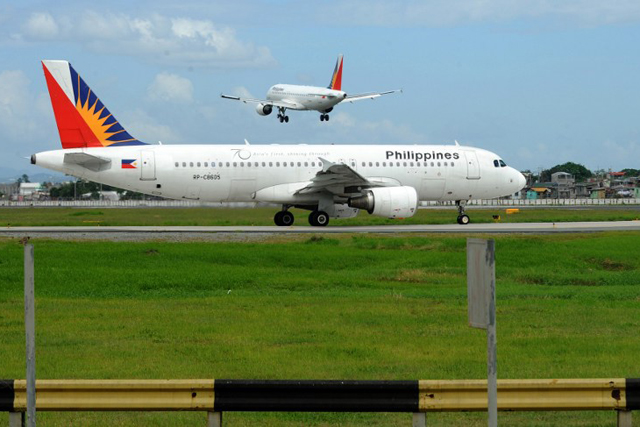SUMMARY
This is AI generated summarization, which may have errors. For context, always refer to the full article.

MANILA, Philippines (2nd Update) – The European Union (EU) now allows Philippine Airlines (PAL) to fly to the 28-nation bloc, partially lifting a ban imposed against the Philippines in 2010.
EU lifted the ban on PAL, citing the Philippines’ efforts in addressing serious air safety concerns, EU ambassador to the Philippines Guy Ledoux announced in a press briefing on Wednesday, July 10.
PAL will start flying to Europe by September or October, its president Ramon Ang said in the same briefing.
However, other Philippine carriers such as budget airline Cebu Pacific, which encountered a mishap at the Davao airport in June, are still barred from entering European airspace and flying over the territory.
“Taking into account the improved safety oversight provided by the competent authorities of the Philippines and the ability of carrier Philippine Airlines to ensure effective compliance with relevant aviation safety regulations, it was decided to lift the ban affecting this carrier,” the EU said in a statement.
“For all other carriers registered in the Philippines, the ban remains as further progress is still needed to reach effective compliance,” it added.
The decision followed the June 26 discussion among members of EU’s Air Safety Committee on whether to lift or keep the ban on Philippine carriers. The committee is composed of technical air safety experts from all EU member states. It meets twice a year.
EU blacklisted Philippine carriers in 2010 after the International Civil Aviation Organization (ICAO) classified the Philippine aviation industry as a “significant safety concern.” Aviation regulator Civil Aviation Authority of the Philippines (CAAP) failed to meet and implement safety standards that ICAO required.
In March, ICAO lifted this classification and announced that the Philippines had complied with internationally binding safety standards established by the 1944 Chicago Convention. The United Nations body acknowledged that after 5 years, CAAP finally accomplished the much-needed reforms.
CAAP and PAL appealed the ban before the EU committee in Brussels in April and again in the committee’s first meeting for the year held June 26.
Cebu Pacific said in a statement Wednesday, July 10 it chose not to participate in said meeting, but hopes to attend the next one later this year.
PAL flights
Ang said PAL’s European destinations would include Amsterdam, London, Paris and Rome.
“As you all know, we recently acquired long-range Airbus aircraft. I think we will be able to launch our first flight by September or October,” he said.
Ang briefly talks about PAL’s plans in the video below.
Citing PAL’s allocations, Ang said the legacy airline may fly to London 7 times a week, and to Paris, 6 times a week. “Others (allocations) we have to revisit,” he noted.
Cebu Pacific said in a statement: “[we hope] to make a representation in another EU Air Safety Committee meeting later this year.”
It said it wants to launch flights to Europe and US, as well as the Middle East and Australia to serve more Filipinos overseas.
Ledoux said the Gokongwei-owned budget airline “needs to continue its effectiveness.”
“An unfortunate incident in June shows some weaknesses,” he said.
A Cebu Pacific plane carrying 165 passengers overshot the runway of the Davao International Airport in June. No one was hurt in the incident, but several passengers complained it took a while before they were ushered out of the aircraft.
The pilots manning the plane were suspended by CAAP. Cebu Pacific received no sanction, but it was asked to comply with a safety action plan.
“We continue to monitor Cebu Pacific. Next meeting is on Nov 29, 2013,” said Ledoux.
US restrictions
CAAP oversees all the players in the aviation industry, including airlines, airport operators, and pilots, among others.
The regulator is also preparing for the audit of its US counterpart – the Federal Aviation Administration (FAA) before yearend.
The US aviation industry regulator downgraded the Philippines to Category 2 from Category 1 in 2008, citing the country’s failure to comply with ICAO standards.
The Category 2 status prohibits Philippine carriers from mounting new and additional flights to the US, one of the most lucrative routes. Airlines in Category 2 countries are also placed under heightened FAA surveillance.
Japan and South Korea reportedly imposed restrictions on Philippine carriers operating in the two countries. These countries blocked the entry of new flights from the Philippines, citing safety concerns due to the Category 2 status.
Tourism and trade
The government earlier admitted that the country’s aviation safety status weighed on tourism industry growth. The government targets to attract 10 million foreign tourists by 2016, and banks on big tourism markets EU and the US.
The EU ban required travel agents to warn passengers against booking trips with carriers from banned countries.
The EU ban and the FAA Category 2 classification led the Philippine government to spin off the regulatory function of the aviation body and set aside budget for the training of aviation inspectors and information technology assets.
Aside from the Philippines, other countries that were banned by EU include Afghanistan, Benin, the two Congos, Djibouti, Eritrea, Equatorial Guinea, Indonesia, Kyrgyztan, Liberia, Sierra Leone, Mozambique, Sao Tome and Principe, Suriname, Sudan, Swaziland and Zambia. – Lala Rimando/Rappler.com
Add a comment
How does this make you feel?
There are no comments yet. Add your comment to start the conversation.